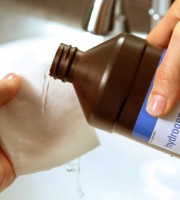
Using hydrogen peroxide is perfect to remove mould from porous materials like clothing, walls and wood, unlike other more aggressive alternatives like bleach.
Hydrogen peroxide can be quite harsh, it’s a mid-strength solution- not quite as strong as bleach, but not quite as weak as vinegar or baking soda solutions.
It’s important to note that hydrogen peroxide has a mild bleaching effect, so it can lighten colours on fabrics and other surfaces. However, it is non-toxic and leaves behind no residue or fumes. You can find hydrogen peroxide in most chemists, look to find some with 3% concentration.
Advantages of using Hydrogen peroxide
- Safe to use on all materials
- Easy to access
- Inexpensive
- Non-toxic
- Leaves behind no residue or fumes
- Penetrates surface of material better than bleach.
Equipment required
- Hydrogen peroxide
- 1 x Spray bottle
- 1 x Water
- 1 x Towel and/or scrubber
- 1 x Safety gloves
Instructions
- Mix 2 parts water and 1 part 3% Hydrogen peroxide into the spray bottle.
- Shake well, and spray generously over the affected area.
- Allow solution to sit for 10 – 15 minutes- it will start cleaning naturally.
- Use the scrubber to brush away stubborn mould stains
- Wipe away any mould debris and allow to dry.
- Repeat the process if necessary.
Safety
While Hydrogen peroxide is non-toxic it can cause irritation to sensitive skin, so it’s always recommended to wear safety gloves.
Prevention
Once your mould colony is treated, it is important to understand that it grew for a reason in the first place. Mould grows due to environment conditions, and in order to prevent the infestation from developing again, some on going treatments and changes may need to be made to your home and/or habits.
Please remember that prevention is the best cure for mould, so please take time to understanding why mould occurs and how you can prevent mould from occurring.
